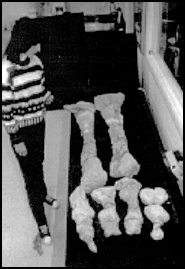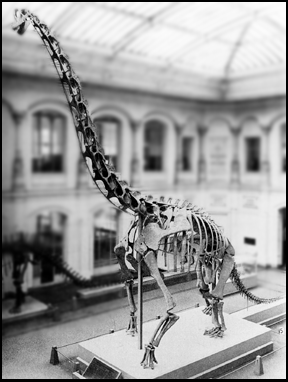 Ron Ratkevitch (forground) collecting "Sonorasaurus"
Ron Ratkevitch (forground) collecting "Sonorasaurus"
 Ron Ratkevitch (forground) collecting "Sonorasaurus"
Ron Ratkevitch (forground) collecting "Sonorasaurus"
"In November 1994, amateur fossil collectors made their way up a southern Arizona canyon in search of fossils. Because of the nature of the sediments in this area, they hoped to discover less common fossils- perhaps even the bones of animals that lived during the Mesozoic, the Age of Reptiles. They had explored dozens of similar canyons over the years, but somehow this one felt very different. petrified logs crumbling on the surface formed a curious fossil pavement between the living sandpaper bush and junipers. Among the ancient wood fragments their eyes detected something unusual, something almost unbelievable: a large mahogany-colored section of a fossilized leg bone.
 Ron Ratkevitch (forground) collecting "Sonorasaurus"
Ron Ratkevitch (forground) collecting "Sonorasaurus"
That fossil fragment eventually led to one of the most remarkable fossil discoveries in Arizona: the partially exposed skeleton of a gigantic dinosaur including ribs, most of a shoulder blade and the rounded surface of a limb joint. The bones were cemented in sandstone of the Turney Ranch Formation. Even though they had seen fragments of dinosaur bones in the area before, the collectors knew that a skeleton of such proportions was a scientific prize."
 Prepared right hind foot of "Sonorasaurus".
Prepared right hind foot of "Sonorasaurus".
"Sonorasaurus" was found in the Santa Rita Mountains, a range similar to that of the Santa Catalinas. The Turney Ranch Formation is thought to be a part of the Bisbee Group, a sequence of continental to marine rocks originally deposited in a series of rift basins that have been subsequently ripped up by Cenozoic extension into many smaller pods of rock, visible only where exposed to erosion in the ranges of the Basin and Range.
According to those working on it "Sonorasaurus" is a brachiosaur similar to the famous Brachiosaurus and its relatives Supersaurus, which are the largest known land animals.
Brachiosaurs are a group of sauropod dinosaurs that were abundant during the Late Jurassic (160 - 145 million years ago) and Early Cretaceous (145-120 million years ago). Once thought to be aquatic "living on soft water plants", sauropods in general are now regarded upright-standing, land-living tree eaters. On the basis of rare stomach contents. sauropods seem to have been specialists at eating conifer foliage. Recall that angiosperms had not yet become dominant during the time sauropods were abundant, and therefore the most abundant foliage was conifer leafy shoots and twigs. According to Ratkevich, "Sonorasaurus" was, "...about 50 feet long and 12 feet high at the shoulder." "When alive ..."Sonorasaurus: would have weighed nearly 35 tons. as much as a small heard of elephants." Even so, "Sonorasaurus" was quite a bit smaller than many other sauropods.
Sauropods were the dominant herbivores during the Jurassic and Early Cretaceous, they probably had an enormous impact on the plant communities in which they lived, probably much greater than living elephants. In modern elephant habitats, the large mammals are regarded by ecologists as
"keystone"
species, because their activities so modify the environment that many other species habitats are dependent on the modifications. Indeed the whole geophysiology of the elephant-containing ecosystems are altered by their presence in ways we are just beginning to comprehend.

 Example of a brachiosaur, from the Late Jurassic
Example of a brachiosaur, from the Late Jurassic